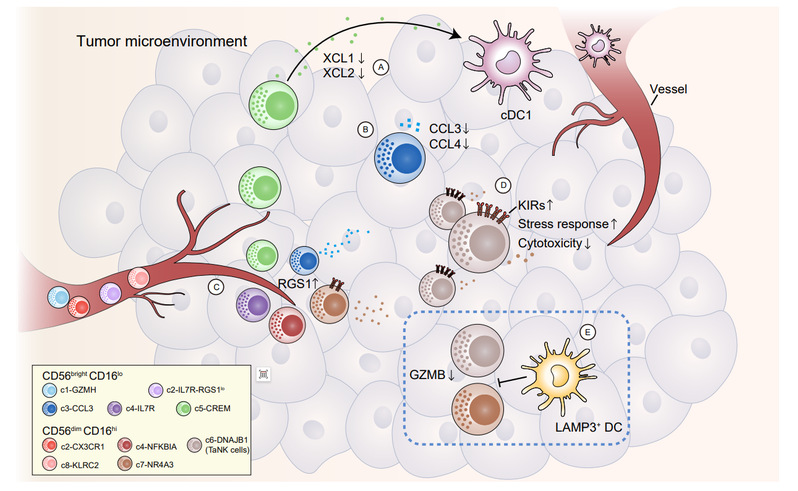Scientists Uncover Aberrant Natural Killer Cell Subtype
A team from the University of Science and Technology of China (USTC) of the Chinese Academy of Sciences (CAS), led by Prof. TIAN Zhigang and Prof. PENG Hui, in collaboration with Prof. ZHANG Zemin from Peking University, have systematically depicted the heterogeneity of natural killer (NK) cells across different cancer types and tissues and discovered a subset of NK cells with aberrant anti-tumor functions that thrive specifically within the tumor microenvironment. Their work was published in Cell on August 21st.
NK cell, named after its ability to directly kill cancer cells, has emerged as a formidable contender in immunotherapy, showcasing exceptional efficacy in blood cancer treatments. However, the heterogeneity of NK cells, varying in phenotype and function within distinct tissue microenvironments, has posed challenges in its application in solid tumor therapy.
Over the years, Prof. TIAN Zhigang and Prof. PENG Hui's team have been at the forefront of investigating the heterogeneity of NK cells across different tissues. In this study, the researchers collected an extensive dataset of single-cell transcriptomes, encompassing 24 cancer types. This dataset included a total of 1,223 samples, drawn from 716 patients and 47 healthy individuals. The researchers systematically identified five distinct subtypes of CD56brightCD16lo NK cells and nine subtypes of CD56dimCD16hi NK cells at a comprehensive pan-cancer level for the first time. These subtypes were then meticulously characterized for their phenotypic and functional diversity.
Through the integration of this extensive dataset, the researchers observed a preference of NK cell subtype composition across different cancer types. Notably, the distribution of NK cell subtypes within tumors, neighboring tissues and peripheral blood displayed significant disparities. Leveraging advanced bioinformatics techniques, the team pinpointed the gene RGS1 as being highly expressed in non-blood NK cells. At transcriptional level, RGS1 demonstrated remarkable specificity and sensitivity, compared to conventional tissue residency markers.
By further probing the tumor microenvironment, the researchers found that a group of DNAJB1+CD56dimCD16hi NK cells were highly enriched in tumor issues. Intriguingly, analysis of this group revealed a dysfunctional phenotype, including reduced cytotoxicity, increased inhibitory receptors, and heightened stress-related protein levels. This subtype, named Tumor-associated NK cells (TaNK cells), defied the conventional understanding that higher NK cell abundance is beneficial to tumor patients. Instead, TaNK cells exhibited a strong association with adverse prognoses in various cancer types and a significant resistance to immunotherapy.
The researchers also discovered that LAMP3+ dendritic cells (DCs) are critical regulators of NK cell functionality. Further spatial distribution data analysis showed that NK cells in close proximity to LAMP3+ DCs exhibited diminished cytotoxic activity. This observation hinted at the potential of LAMP3+ DCs to exert abnormal regulatory effects on NK cell function in the tumor microenvironment.

Schematics of NK cell features and dynamics. (Image by PENG Hui et al.)
In summary, this research innovatively leverages the extensive single-cell data analysis to unravel shifts in gene expression patterns within NK cells. Beyond shedding light on the potential of NK cell-based immunotherapies, these findings provided a foundation for exploring novel biomarkers and therapeutic targets.
Paper link: https://doi.org/10.1016/j.cell.2023.07.034
(Written by QIU Rong, edited by ZHANG Yihang, USTC News Center)
Back
